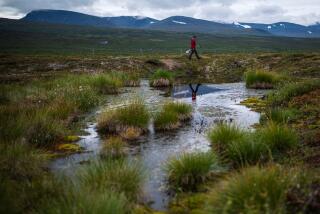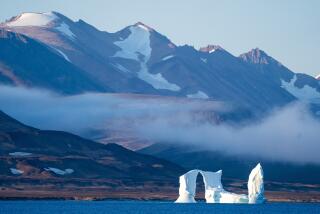How much Arctic sea ice are you melting? Scientists have an answer

Scientists have found for every metric ton of carbon dioxide released into the air, three square meters of Arctic sea ice disappear.
Climate change may sometimes seem so big and abstract that it can be difficult to grasp the scope of the problem. But now, scientists have found a way to bring the numbers down to Earth: For every metric ton of carbon dioxide released into the air, three square meters of Arctic sea ice disappear. If you do the math, this means the average American is melting roughly 50 square meters of those frozen reserves every year.
The findings, published in the journal Science, highlight the direct effect that individuals have on climate change — and what it means for the Arctic’s shrinking sea ice.
“For us, this is really the first time that we do have an intuitive understanding of how our individual actions really contribute to global warming,” said lead author Dirk Notz, a climate scientist at the Max Planck Institute for Meteorology in Hamburg, Germany. “So far, when we talked about global warming, it was always these very big numbers, like billions of tons of carbon dioxide — or very small numbers, like 0.1 degree of temperature change or something. But now suddenly, with this three-square-meter loss per ton of CO2, it gives a very, very concrete and intuitive understanding of how we all cause Arctic sea ice to melt.”
Carbon dioxide acts as a greenhouse gas; it traps heat in the Earth’s atmosphere, forcing the global temperature higher and higher. (It also acidifies the world’s oceans, making it difficult for sea creatures to build their shells and corals to build reefs.) And human activity, thanks in large part to the fossil fuels we burn, is speeding up the release of carbon dioxide.
Scientists have already documented the myriad impacts that climate change, spurred on by greenhouse gas, has wrought on the environment. Weather events and droughts are becoming more extreme; diseases are spreading more easily; many species are going extinct as their habitats disappear. And of course, ice sheets in both the Arctic and Antarctic are melting, causing ocean levels to rise.
Sea ice, which is water that freezes out of the ocean, goes through an annual cycle: It grows in the winter and starts to melt as the weather warms. Eventually, if global warming continues, summer sea ice will melt entirely. This also accelerates rising global temperatures, said Cecilia Bitz, an atmospheric scientist at the University of Washington in Seattle, who was not involved in the study. That’s because sea ice reflects sunlight, whereas the ocean absorbs it. With less sea ice protecting the Earth’s surface, the ocean will absorb more energy, and grow even warmer.
But estimates don’t all agree about when exactly the Arctic will be ice-free — some models put it at the beginning of this current century, while others say it will still have ice well into the next.
Climate change has always had this fairly abstract notion. It was almost impossible ... to figure out how my own actions make a difference.
— Dirk Notz, climate scientist at the Max Planck Institute for Meteorology
But Notz and study coauthor Julienne Stroeve of the the National Snow and Ice Data Center in Boulder, Colo., noticed something odd: Several decades of climate data has allowed scientists to quantify the relationship between carbon dioxide emissions and temperature, and the relationship between temperature and the loss of sea ice. So why hadn’t anyone used these two rates to find the link between carbon dioxide and sea ice loss?
“It’s one of those things that, in retrospect, sounds so obvious,” Notz said.
The scientists calculated that about three square meters of Arctic sea ice was lost for every metric ton of carbon dioxide released. Since the average American produces roughly 16.39 metric tons per year (as of 2013), it means each individual is responsible for about 50 square meters of lost sea ice.
“I have stood on sea ice,” Bitz said. “I imagine I occupy about a meter squared, and the thought of being responsible for the destruction of maybe 50 square meters a year is, well, depressing — and profound.”
To put that in further perspective, Notz said, it means that driving about 2,500 miles in the average American car results in another three square meters of melted ice. A round-trip plane ride from New York to London costs another three square meters or so of Arctic sea ice.
See the most-read stories in Science this hour »
“Even for me as a climate scientist, climate change has always had this fairly abstract notion,” Notz said. “And it was almost impossible, for myself, to figure out how my own actions make a difference. But now with these numbers ... it suddenly becomes very tangible.”
The Paris agreement on climate change, which went into effect Thursday afternoon (at midnight in Europe), set a cap for carbon dioxide emissions at 1 trillion metric tons, in order to limit the global temperature rise to 2 degrees Celsius. But Notz calculated that 1 trillion metric tons of the greenhouse gas would melt Arctic summer sea ice for good.
“We might be able to keep global warming below two degrees, but Arctic sea ice will be gone by that point,” Notz said.
Follow @aminawrite on Twitter for more science news and “like” Los Angeles Times Science & Health on Facebook.
MORE IN SCIENCE
Feeling anxious about the election? Here’s how to cope with election stress disorder
Every year of smoking causes DNA mutations that make cancer more likely
Feds say 25% of California is drought-free, but state experts are still cautious
UPDATES:
7:50 p.m.: This article was updated with comment from Cecilia Bitz and with additional details on the findings.
This story was originally published at 5:15 p.m.







